
 |
|
| Home | Our Research | Luna / L98 | Active Sonar | Donate & Act Now | About Us | |
|
As we are on the water conducting identification and acoustical research, we cannot help
but be thrilled and captivated by the spectacular displays of the humpback whales.
As we observe these behaviors, we attempt to identify the actor, categorize their behavior,
and add these notes to our identification database.
There are several broad categories of behavior: feeding, migrating, socializing and mating. For the North Pacific humpbacks, feeding occurs in the icy waters of Alaska during the summer months; reproduction occurs in the warm waters of Hawaii during the winter, and of course migrating occurs while the whales are swimming between the two. There are a great many behaviors which only occur during the winter months in Hawaii, and others which only occur during the summer months in Alaska. All of the photos below were taken during the winter of our 2002 field research off Maui, Hawaii. |
|
Most people have seen Killer whales and/or dolphins swim around a tank, building up speed,
and then jump out of the water. What most people don't realize is that Humpback whales
are capable of lifting their 45 ton bodies - nearly entirely out of the water
with only two beats of their massive flukes. They have been observed lying just
2-3 feet under the surface of the water, and then 2 instantaneous beats later, breaching!
Although no one can say for certain why humpbacks breach, most theorize that it is a form of communication, a method of dislodging parasites, or simply an enthusiastic and playful display. |
 |
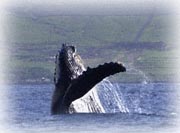 |
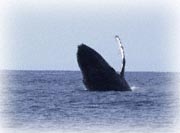 |
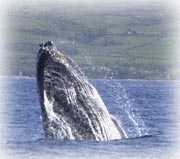 |
| Humpback whales are very curious creatures. Oftentimes, they will swim up along side of our research vessel, just to take a look. One behavior often seen is called 'spy hopping' - where they simply poke their heads out of the water for a look around. |
 |
 |
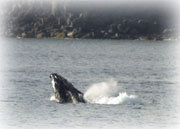 |
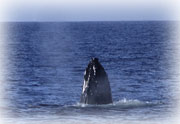 |
| The peduncle muscle at the base of the humpback's tail is believed to be the strongest muscle in the animal kingdom. It is this muscle which is used to propel their great mass out of the water during breaching, and can also be used to slap their tail against the water. In the waters of Alaska, it is thought to be a fishing technique, stunning schools of fish so that they become inactive and can then be swallowed. In the waters of Hawaii, since the whales are not feeding, it is thought to be a show of aggression. |
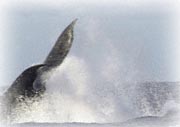 |
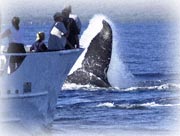 |
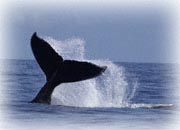 |
 |
| The bottom line on all of these behaviors is that we, as humans, simply don't know enough about these fascinating creatures to say for sure what they're doing. More research is needed, and your contributions can help make that possible. |